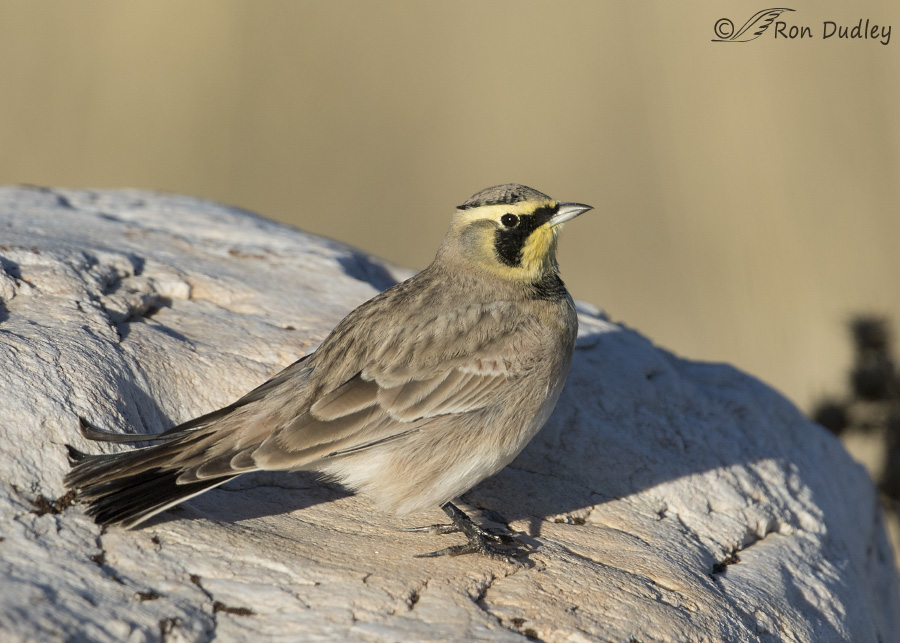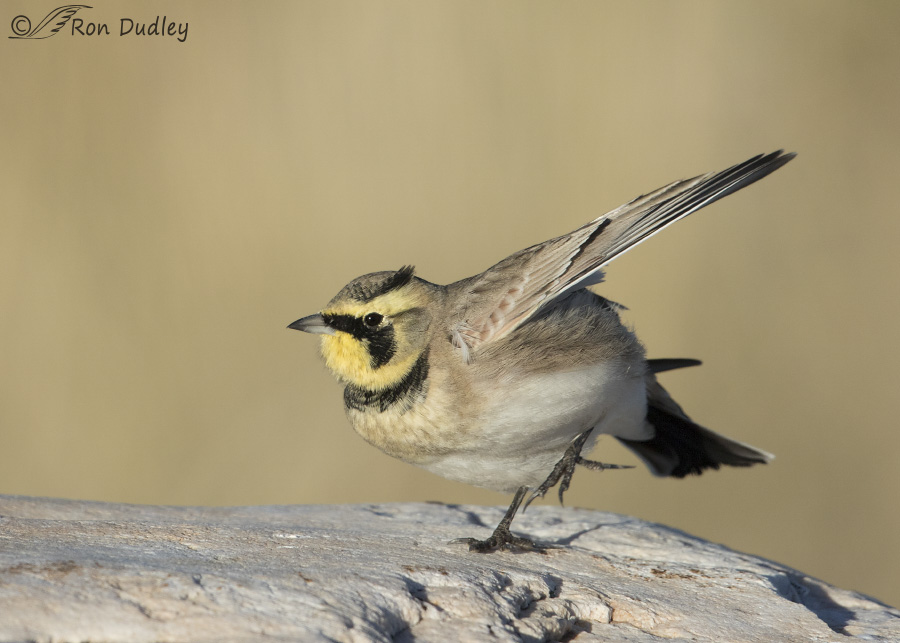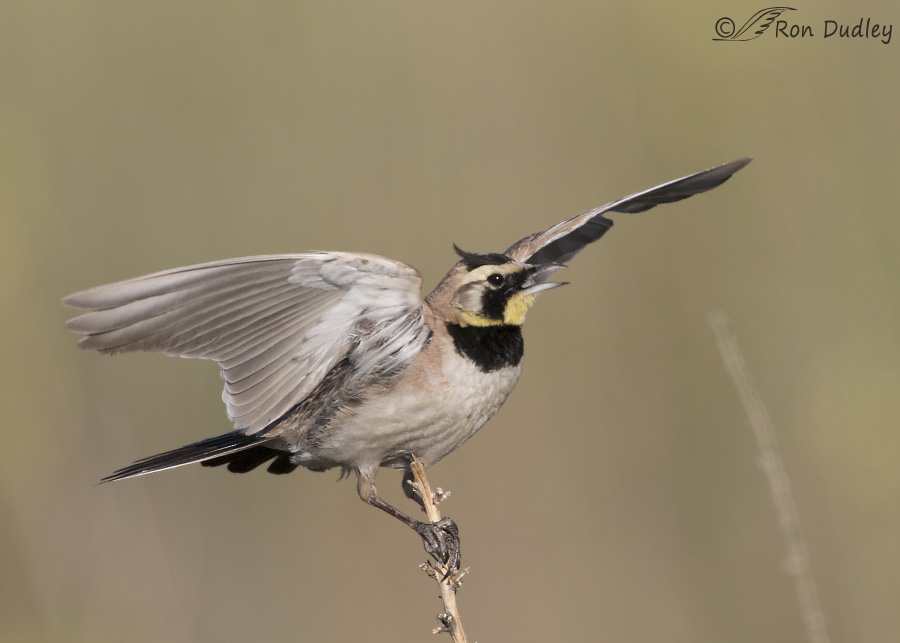Horned Larks are one of the most common and widespread bird species on earth but I don’t believe they get the respect they deserve. They’re often largely overlooked by birders and photographers, presumably because they’re so common, but when seen up close I think they’re beautiful birds. They’re also tough little devils – in some of the harsher habitats in their range the only breeding bird species are Horned Larks and the equally resilient Common Raven.
The first two images below were taken two days ago and the third in June of this year, all on Antelope Island.

1/3200, f/6.3, ISO 500, Canon 7D Mark II, Canon EF500mm f/4L IS II USM +1.4 tc, not baited, set up or called in
When I think of Horned Larks the word “subtle” always comes to mind. From a distance they appear to be just another “little brown job” (as Elephant’s Child might call them) but up close their delicate colors and plumage patterns are quite attrractive and they have subtle songs and personalities to match, though fighting males are far from subtle about their aerial combat. When I’m watching one of these birds through my lens I’m always struck by the sweet, delicate tinkling quality of their soft songs and calls which they perform year-round and even in flight.
If you’re interested here’s a link to their songs. The “mixed song” is the one I hear most often.

1/3200, f/6.3, ISO 500, Canon 7D Mark II, Canon EF500mm f/4L IS II USM +1.4 tc, not baited, set up or called in
But I think they’re a quirky species because they’re so “twitchy”. They’ll be singing softly away and suddenly they’ll jerk into a weird posture for an instant for no apparent reason. The next time they do it the posture will be different but if you wait long enough it’ll happen. Whenever I’m photographing Horned Larks I always try to use relatively fast shutter speeds to freeze the motion because it’s very quick when it happens. And they don’t give you any warning either so it’s impossible to anticipate.

1/3200, f/6.3, ISO 500, Canon 7D Mark II, Canon EF500mm f/4L IS II USM +1.4 tc, not baited, set up or called in
This male twitched for me while perched on an old sunflower stem – usually I only get them perched on rocks. It didn’t take off and as far as I could tell it wasn’t reacting to another bird – it just apparently had the urge to twitch.
Speaking of weirdness involving Horned Larks, while I was researching this post (trying to find an explanation for what I call “twitching”) I ran across a little tidbit that really surprised me. Birds of North America Online out of Cornell gives a list of nest predators of Horned Larks (nest predators are those that prey on eggs or small young). The nest predators they list include a variety of small mammals (meadow voles, shrews and deer mice) and a few birds including the American Crow but that list also included the Western Meadowlark.
I had no idea that meadowlarks preyed on eggs and/or young of other bird species. There’s always something new to learn about birds.
Ron


Beautiful shots Ron! These beautiful birds are not so common in our area of Missouri.
Charlotte
Thanks very much, Charlotte.
Patty, you are too funny. We have the birds here Ron. I too enjoy their song. Very elusive birds though. They are always hiding in the shrubs. Sadly, the field where the birds have been for years, now has a 4 sale sign on it.
“Sadly, the field where the birds have been for years, now has a 4 sale sign on it.”
That sounds ominous, Jean. Hope a developer doesn’t buy it.
I hope that no-one thinks I am dismissive of the little brown jobs. They so very often have a subtle beauty which I savour. And these stunners are an elegant example of that beauty. Not common here. At all.
No one who knows you like we do would ever think that, EC.
Beautiful birds! I like their coloration a lot. They may be common for you, but I have never seen a Horned Lark. So I’m glad that you posted these images.
Thanks, Susan. I’ve been trying to post more images of common species lately and it’s nice to know they’re appreciated.
I wish I’d paid more attention to the birds when I was on the reservation and in the Summer hambleyca camps…think I missed out on a lot…too busy with ceremonies and socializing…too late now, nuts!!!
Patty, I have a few regrets involving my younger days too but most of them are things I wish I HADN’T done rather than had done. Several of them involved beer…
Ooooh,boy! ME, too! As for beer, never learned to like the stuff, but LOVE the smell!
Patty, I never liked beer when I was young. But in our older age my husband and I have become ‘beer hounds’, seeking out craft breweries, and when it’s really good beer, we enjoy it greatly. Some are definitely an acquired taste, but many are very easy to like.
YUK!!!!!!!
Great shots Ron.
I’m afraid I have to respectfully disagree about Vermont Horned Larks. They are NOT common here in Vermont until winter. During our winter birding sojourns I ALWAYS look forward to the chance of seeing Horned Larks and the possibility of a Lapland Longspur mixed in the group. Each winter it is a joy to see the Horned Larks, Lapland Longspurs and Snow Buntings along with whatever finches have decided to grace us with their presence. I’m always routing for these tough northern birds!
Dick, No, they’re not common everywhere or at all times – that goes without saying. We’re lucky enough to have them here year-round. I’m glad that you enjoy them too.
We don’t have these in the Ozarks. Miss them, would see them during migration in Texas.
I’d miss them too, Jo.
Don’t know if I’ve ever seen one – they are pretty. Surprising about the Meadow Larks. Wonder if they also prey on the Killdeer eggs?
Judy, I just looked up Killdeer nest predators on BNA. They don’t list meadowlarks as one of them but that doesn’t mean that it doesn’t happen…
They aren’t common to me…we don’t have any. I love their soft beauty and those sassy little “horns”…was surprised to learn about some of their predators, including Meadow Larks and voles. The bird in the second frame was apparently doing the Mexican Hat Dance…you just didn’t recognize the music….
The meadowlarks surprised me too, Patty. I’ll have to listen more carefully for that music!